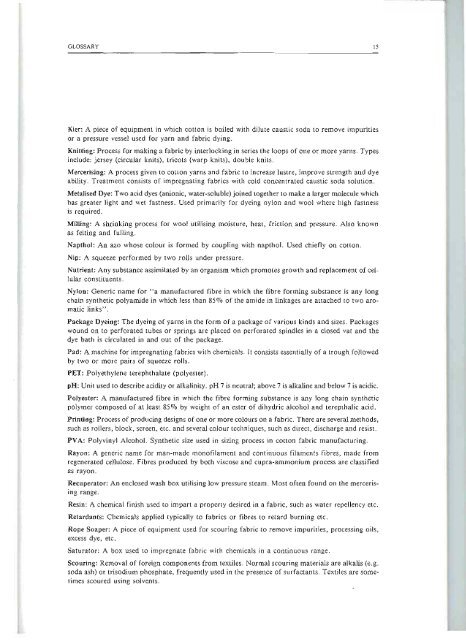Contributor, The Textile Industry and the Environment, UNEP
Contributor, The Textile Industry and the Environment, UNEP
Contributor, The Textile Industry and the Environment, UNEP
Create successful ePaper yourself
Turn your PDF publications into a flip-book with our unique Google optimized e-Paper software.
GLOSSARY<br />
Kier: A piece of equipment in which coHan is boiled with dilute caustic soda to remove impurities<br />
or a pressure vessel used for yarn <strong>and</strong> fabric dying.<br />
Knitting: Process for making a fabric by interlocking in series <strong>the</strong> loops of one or more yarns. Types<br />
include: jersey (circular knits), tricots (warp knits), double knits.<br />
Mercerising: A process given to cotton yarns <strong>and</strong> fabric to increase lustre, improve strength <strong>and</strong> dye<br />
ability. Treatment consists of impregnating fabrics with cold concentrated caustic soda solution.<br />
Metalised Dye: Two acid dyes (anionic, water-soluble) jo(ned toge<strong>the</strong>r to make a larger molecule which<br />
has greater light <strong>and</strong> wet fastness. Used primarily for dyeing nylon <strong>and</strong> wool where high fastness<br />
is required.<br />
Milling: A shrinking process for wool utilising moisture, heat, friction <strong>and</strong> pressure. Also known<br />
as felting <strong>and</strong> fulling.<br />
Napthol: An azo whose colour is formed by coupling with napthol. Used chiefly on cotton.<br />
Nip: A squeeze performed by two rolls under pressure.<br />
Nutrient: Any substance assimilated by an organism which promotes growth <strong>and</strong> replacement of cellular<br />
constituents.<br />
Nylon: Generic name for "a manufactured fibre in which <strong>the</strong> fibre forming substance is any long<br />
chain syn<strong>the</strong>tic polyamide in which less than 85070 of <strong>the</strong> amide in linkages are attached to two aromatic<br />
links".<br />
Package Dyeing: <strong>The</strong> dyeing of yarns in <strong>the</strong> form of a package of various kinds <strong>and</strong> sizes. Packages<br />
wound on to perforated tubes or springs are placed on perforated spindles in a closed vat <strong>and</strong> <strong>the</strong><br />
dye bath is circulated in <strong>and</strong> out of <strong>the</strong> package.<br />
Pad: A machine for impregnating fabrics with chemicals. It consists essentially of a trough followed<br />
by two or more pairs of squeeze rolls.<br />
PET: Polyethylene terephthalate (polyester).<br />
pH; Unit used to descri be acidity or alkalinity. pH 7 is neutral; above 7 is alkaline <strong>and</strong> below 7 is acidic.<br />
Polyester: A manufactured fibre in which <strong>the</strong> fibre forming substance is any long chain syn<strong>the</strong>tic<br />
polymer composed of at least 85% by weigh! of all. ester of dihydric alcohol <strong>and</strong> terepthalic acid.<br />
Printiog: Process of producing designs of one or more colours on a fabric. <strong>The</strong>re are several methods,<br />
such as rollers, block, screen, etc. <strong>and</strong> several colour techniques, such as direct, discharge <strong>and</strong> resist.<br />
PVA: Polyvinyl Alcohol. Syn<strong>the</strong>tic size used in sizing process in cotton fabric manufacturing.<br />
Rayon: A generic name for man-made monofilament <strong>and</strong> continuous filaments fibres, made from<br />
regenerated cellulose. Fibres produced by both viscose <strong>and</strong> cupra-ammonium process are classified<br />
as rayon.<br />
Recuperato(: An enclosed wash box utilising low pressure steam. Most often found on <strong>the</strong> mercerising<br />
range.<br />
Resin: A chemical finish used to impart a property desired in a fabric, such as water repellency etc.<br />
Retardants; Chemicals applied typically to fabrics or fibres to retard burning etc.<br />
Rope Soaper; A piece of equipment used for scouring fabric to remove impurities, processing oils,<br />
excess dye, etc.<br />
Saturator: A box used to impregnate fabric with chemicals in a continuous range.<br />
Scouring: Removal of foreign components from textiles. Normal scouring materials are alkalis (e.g.<br />
soda ash) or trisodium phosphate, frequently used in <strong>the</strong> presence of surfaetants. <strong>Textile</strong>s are sometimes<br />
scoured using solvents.<br />
15

















